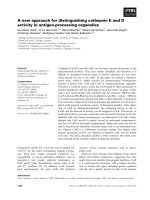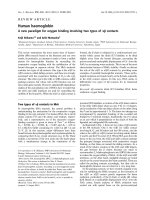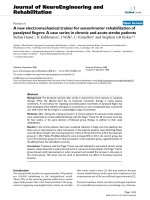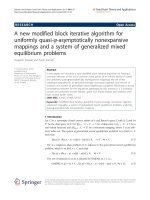Báo cáo hóa học: " A new algorithm for computing distance matrix and Wiener index of zig-zag polyhex nanotubes" doc
Bạn đang xem bản rút gọn của tài liệu. Xem và tải ngay bản đầy đủ của tài liệu tại đây (232.42 KB, 5 trang )
NANO EXPRESS
A new algorithm for computing distance matrix and Wiener index
of zig-zag polyhex nanotubes
Ali Reza Ashrafi Æ Shahram Yousefi
Received: 31 December 2006 / Accepted: 20 February 2007 / Published online: 10 April 2007
Ó to the authors 2007
Abstract The Wiener index of a graph G is defined as the
sum of all distances between distinct vertices of G. In this
paper an algorithm for constructing distance matrix of a
zig-zag polyhex nanotube is introduced. As a consequence,
the Wiener index of this nanotube is computed.
Keywords Zig-zag polyhex nanotube Á Distance matrix Á
Wiener index
Introduction
Carbon nanotubes form an interesting class of carbon
nanomaterials. These can be imagined as rolled sheets of
graphite about different axes. These are three types of
nanotubes: armchair, chiral and zigzag structures. Further
nanotubes can be categorized as single-walled and multi-
walled nanotubes and it is very difficult to produce the
former.
Graph theory has found considerable use in chemistry,
particularly in modeling chemical structure. Graph theory
has provided the chemist with a variety of very useful
tools, namely, the topological index. A topological index is
a numeric quantity that is mathematically derived in a
direct and unambiguous manner from the structural graph
of a molecule. It has been found that many properties of a
chemical compound are closely related to some topological
indices of its molecular graph [1, 2].
Among topological indices, the Wiener index [3]is
probably the most important one. This index was intro-
duced by the chemist H. Wiener, about 60 years ago to
demonstrate correlations between physico-chemical prop-
erties of organic compounds and the topological structure
of their molecular graphs. Wiener defined his index as the
sum of distances between two carbon atoms in the mole-
cules, in terms of carbon–carbon bonds. Next Hosoya
named such graph invariants, topological index [4]. We
encourage the reader to consult Refs. [5–7] and references
therein, for further study on the topic.
The fact that there are good correlations between and a
variety of physico-chemical properties of chemical com-
pounds containing boiling point, heat of evaporation, heat
of formation, chromatographic retention times, surface
tension, vapor pressure and partition coefficients could be
rationalized by the assumption that Wiener index is
roughly proportional to the van der Waals surface area of
the respective molecule [8].
Diudea was the first chemist which considered the
problem of computing topological indices of nanostruc-
tures [9–15]. The presented authors computed the Wiener
index of a polyhex and TUC
4
C
8
(R/S) nanotori [16–18]. In
this paper, we continue this program to find an algorithm
for computing distance matrix of a zig-zag polyhex nano-
tube. As an easy consequence, the Wiener index of this
nanotube is computed.
John and Diudea [9] computed the Wiener index of zig-
zag polyhex nanotube T = T(p, q) = TUHC
6
[2p,q], for the
first times. In this paper, distance matrix of these nanotubes
are computed. As an easy consequence of our results, a
matrix method for computing the Wiener index of a zig-zag
polyhex nanotube is introduced. We also prepare an
A. R. Ashrafi (&)
Institute for Nanoscience and Nanotechnology, University of
Kashan, Kashan, Iran
e-mail: ashrafi@kashanu.ac.ir
S. Yousefi
Center for Space Studies, Malek-Ashtar University of
Technology, Tehran, Iran
123
Nanoscale Res Lett (2007) 2:202–206
DOI 10.1007/s11671-007-9051-y
algorithm for computing distance matrix of these nanotubes.
Throughout this paper, our notation is standard. They are
appearing as in the same way as in the following [2, 19].
Main results and discussion
In this section, distance matrix and Wiener index of the
graph T = TUHC
6
[m,n], Fig. 1, were computed. Here m is
the number of horizontal zig-zags and n is the number of
columns. It is obvious that n is even and |V(T)| = mn.
An algorithm for constructing distance matrix of
TUHC
6
[m,n]
We first choose a base vertex b from the 2-dimensional lattice
of T and assume that x
ij
is the (i,j)th vertex of T, Fig. 2.
Define D
ð1;1Þ
mÂn
¼½d
ð1;1Þ
i;j
; where d
ð1;1Þ
i;j
is distance between (1,1)
and (i,j), i = 1, 2, , m and j = 1, 2, , n. By Fig. 2, there are
two separates cases for the (1,1)th vertex. For example in the
case (a) of Fig. 2,d
ð1;1Þ
1;1
¼ 0; d
ð1;1Þ
1;2
¼ d
ð1;1Þ
2;1
¼ 1 and in case
(b), d
ð1;1Þ
1;1
¼ 0; d
ð1;1Þ
1;2
¼ 1; d
ð1;1Þ
2;1
¼ 3: In general, we assume
that D
ðp;qÞ
mÂn
is distance matrix of T related to the vertex (p,q)
and s
ðp;qÞ
i
is the sum of ith row of D
ðp;qÞ
mÂn
: Then there are two
distance matrix related to (p,q) such that s
ðp;2kÀ1Þ
i
¼ s
ðp;1Þ
i
;
s
ðp;2kÞ
i
¼ s
ðp;2Þ
i
; 1 k n=2; 1 i m; 1 p m:
By Fig. 2 and previous notations, if b varies on a column
of T then the sum of entries in the row containing base
vertex is equal to the sum of entries in the first row of
D
ð1;1Þ
mÂn
: On the other hand, one can compute the sum of
entries in other rows by distance from the position of base
vertex. Therefore,
s
ði;jÞ
k
¼
s
ð1;1Þ
iÀkþ1
1 k i m; 1 j n
s
ð1;2Þ
kÀiþ1
1 i k m; 1 j n
(
If 2j(i+j)
s
ði;jÞ
k
¼
s
ð1;2Þ
iÀkþ1
1 k i m; 1 j n
s
ð1;1Þ
kÀiþ1
1 i k m; 1 j n
(
If 2-(i + j)
We now describe our algorithm to compute distance
matrix of a zig-zag polyhex nanotube. To do this, we define
matrices A
ðaÞ
mÂðn=2þ1Þ
¼½a
ij
; B
mÂðn=2þ1Þ
¼½b
ij
and
A
ðbÞ
mÂðn=2þ1Þ
¼½c
ij
as follows:
a
1,1
=0 a
1,2
=1 a
i;j
¼
a
i;1
2-j
a
i;2
2jj
&
;
a
i;1
¼ a
iÀ1;1
þ 1; a
i;2
¼ a
i;1
þ 1; 2ji
a
i;2
¼ a
iÀ1;2
þ 1; a
i;1
¼ a
i;2
þ 1; 2-i
c
1,1
=0 c
1,2
=1 c
i;j
¼
c
i;1
2-j
c
i;2
2jj
&
;
c
i;2
¼ c
iÀ1;2
þ 1; c
i;1
¼ c
i;2
þ 1; 2ji
c
i;1
¼ c
iÀ1;1
þ 1; c
i;2
¼ c
i;1
þ 1; 2-i
b
i,1
= i–1; b
i,j
=b
i,j–1
+1
For computing distance matrix of this nanotube we must
compute matrices D
ðaÞ
mÂn
¼½d
a
i;j
and D
ðbÞ
mÂn
¼½d
b
i;j
: But by
our calculations, we can see that
d
a
i;j
¼
Maxfa
i;j
; b
i;j
g 1 j n=2
d
i;nÀjþ2
j[n=2 þ1
&
and
d
b
i;j
¼
Maxfa
i;j
; c
i;j
g 1 j n=2
d
i;nÀjþ2
j[n=2 þ1
&
This completes calculation of distance matrix.
Computing Wiener index of TUHC
6
[m,n]
In previous section, distance matrix D
ðp;qÞ
mÂn
related to vertex
(p,q) is computed. Suppose s
ðp;qÞ
i
is the sum of ith row of
D
ðp;qÞ
mÂn
: Then s
ðp;2kÀ1Þ
i
¼ s
ðp;1Þ
i
and s
ðp;2kÞ
i
¼ s
ðp;2Þ
i
; where
1 k n=2; 1 i m; 1 p m: On the other
hand, by our calculations in section ‘‘An algorithm for
constructing distance matrix of TUHC
6
[m,n]’’,
Fig. 1 The zig-zag polyhex nanotube TUHC
6
[20,n]
(1,1)
(1,1)
x
1,3
2,2
x
Base
Base
(a)
(b)
Fig. 2 Two basically different cases for the vertex b
Nanoscale Res Lett (2007) 2:202–206 203
123
s
ð1;2kÀ1Þ
i
¼
n
2
4
þ (n þi À 2Þði À1Þ i
n
2
þ 1
n
2
(4i À5Þ i !
n
2
þ 1
(
s
ð1;2kÞ
i
¼
n
2
4
þ (n þiÞði À1Þ i
n
2
þ 1
n
2
(4i À3Þ i !
n
2
þ 1
(
;
1 i m; 1 k
n
2
:
Suppose S
ðaÞ
p
and S
ðbÞ
p
are the sum of all entries of dis-
tance matrix D
ðp;qÞ
mÂn
in two cases (a) and (b). Then
S
ðaÞ
1
¼
(mn/4)(2mþnÀ2Þþðm=3ÞðmÀ1ÞðmÀ2Þm n=2þ1
(mn/2)(2mÀ3Þþðn=24Þðnþ2Þðnþ4Þ m!n=2þ1
&
;
S
ðbÞ
1
¼
(mn/4)(2mþnÀ2Þþðm=3Þ m
2
À1ðÞm n=2þ1
(mn/2)(2mÀ1Þþðn=24Þ n
2
À4ðÞm!n=2þ1
&
:
If p is arbitrary then one can see that:
S
ðaÞ
p
¼ S
ðaÞ
1
þ
X
p
i¼2
s
ð1;2Þ
i
À
X
m
i¼mÀpþ2
s
ð1;1Þ
i
S
ðbÞ
p
¼ S
ðbÞ
1
þ
X
p
i¼2
s
ð1;1Þ
i
À
X
m
i¼mÀpþ2
s
ð1;2Þ
i
Thus it is enough to compute S
ðaÞ
p
and S
ðbÞ
p
: When
m £ n/2, one can see that:
S
ðaÞ
p
¼(mn/4)(2m þn þ 2Þþðm=3Þ m
2
À 1
ÀÁ
À pm
2
þ mn þ n
ÀÁ
þ p
2
(m þn)
S
ðbÞ
p
¼(mn/4)(2m þn þ2Þþðm=3Þðm þ1Þðm þ 2Þ
À pm
2
þ mn þ n þ2m
ÀÁ
þ p
2
(m þn)
To complete our argument, we must investigate the case
of m > n/2 + 1. To do this, we consider three cases that
p £ n/2 + 1, p £ m – n/2 + 1; m £ n + 1, m – n/2 + 1 <
p £ n/2 + 1 and m > n + 1, p > n/2 + 1.
(I) p
n
2
þ 1 and p m À
n
2
þ 1: In this case we have:
S
ðaÞ
p
¼
mn
2
ð2mþ1Þþ
n
24
n
2
À4
ÀÁ
þ
p
12
ð3n
2
À24mnÀ12nÀ4Þþ
3n
2
p
2
þ
p
3
3
S
ðbÞ
p
¼
mn
2
ð2mþ3Þþ
n
24
ðnÀ2ÞðnÀ4Þ
þ
p
12
3n
2
À24mnÀ24nþ8
ÀÁ
þ
p
2
2
ð3nÀ2Þþ
p
3
3
(II) m £ n + 1 and m À
n
2
þ 1\p
n
2
þ 1: Therefore,
S
ðaÞ
p
¼
mn
4
(2m þn þ 2Þþ
m
3
ðm
2
À 1Þ
À pm
2
þ mn þ n
ÀÁ
þ p
2
(m þn)
S
ðbÞ
p
¼
mn
4
(2m þn þ 2Þþ
m
3
(m þ1Þðm þ 2Þ
À pm
2
þ mn þ n þ2m
ÀÁ
þ p
2
(m þn)
(III) m > n + 1 and p[
n
2
þ 1: In this case,
S
ðaÞ
p
¼
n
12
n
2
À 4
ÀÁ
þ
n
2
(m À2pÞð2m þ 1Þþ2np
2
S
ðbÞ
p
¼
n
12
n
2
þ 8
ÀÁ
þ
n
2
(m À2pÞð2m þ 3Þþ2np
2
Therefore,
W
mÂn
¼
ðn=2Þ
"
P
ðmÀ1Þ=2
i¼1
S
ðaÞ
i
þS
ðbÞ
i
þð1=2Þ S
ðaÞ
ðmþ1Þ=2
þS
ðbÞ
ðmþ1Þ=2
#
2-m
ðn=2Þ
P
m=2
i¼1
S
ðaÞ
i
þS
ðbÞ
i
2jm
8
>
>
>
>
>
>
>
>
>
>
<
>
>
>
>
>
>
>
>
>
>
:
:
We now substitute the values of S
ðaÞ
p
to compute the
Wiener index of T, as follows:
W
mÂn
¼
mn
2
24
4m
2
þ3mnÀ4ðÞþ
m
2
n
12
m
2
À1ðÞm
n
2
þ1
mn
2
24
8m
2
þn
2
À6ðÞÀ
n
3
192
n
2
À4ðÞm[
n
2
þ1
(
:
Constructing distance matrices of some nanotubes
In this section, distance matrices of TUHC
6
[8,10] and
TUHC
6
[8,16] together with their Wiener indices are com-
puted. To construct distance matrices of TUHC
6
[8,10], we
must compute matrices A
ðaÞ
8Â6
; A
ðbÞ
8Â6
and B
8 · 6
. By defi-
nition of these matrices, we have:
A
ðaÞ
8Â6
¼
010101
121212
434343
565656
878787
910910910
12 11 12 11 12 11
13 14 13 14 13 14
2
6
6
6
6
6
6
6
6
6
6
6
6
6
4
3
7
7
7
7
7
7
7
7
7
7
7
7
7
5
;
204 Nanoscale Res Lett (2007) 2:202–206
123
A
ðbÞ
8Â6
¼
010101
323232
454545
767676
898989
11 10 11 10 11 10
12 13 12 13 12 13
15 14 15 14 15 14
2
6
6
6
6
6
6
6
6
6
6
4
3
7
7
7
7
7
7
7
7
7
7
5
B
8Â6
¼
012 3 4 5
123 4 5 6
234 5 6 7
345 6 7 8
456 7 8 9
567 8 9 10
67891011
789101112
2
6
6
6
6
6
6
6
6
6
6
4
3
7
7
7
7
7
7
7
7
7
7
5
:
We now compute matrices D
ðaÞ
8Â10
and D
ðbÞ
8Â10
: By defi-
nition, entries of the first n/2 + 1 columns of these matrices
are maximum values of fA
ðaÞ
8Â6
; B
8 · 6
} and fA
ðbÞ
8Â6
; B
8Â6
g;
respectively. Thus,
D
ðaÞ
8Â10
¼
0123454321
1234565432
4345676543
5656787656
8787898787
9 10 9 10 9 10 9 10 9 10
12 11 12 11 12 11 12 11 12 11
13 14 13 14 13 14 13 14 13 14
2
6
6
6
6
6
6
6
6
6
6
4
3
7
7
7
7
7
7
7
7
7
7
5
;
D
ðbÞ
8Â10
¼
0123454321
3234565432
4545676545
7676787676
8989898989
11 10 11 10 11 10 11 10 11 10
12 13 12 13 12 13 12 13 12 13
15 14 15 14 15 14 15 14 15 14
2
6
6
6
6
6
6
6
6
6
6
4
3
7
7
7
7
7
7
7
7
7
7
5
This implies that W(TUHC
6
[8,10]) = 19,700. To con-
struct distance matrices of TUHC
6
[8,16], we must compute
matrices A
ðaÞ
8Â9
and A
ðbÞ
8Â9
: Using a similar argument as
above, we have:
A
ðaÞ
8Â9
¼
010101010
121212121
434343434
565656565
878787878
9 10 9 10 9 10 9 10 9
12 11 12 11 12 11 12 11 12
13 14 13 14 13 14 13 14 13
2
6
6
6
6
6
6
6
6
6
6
4
3
7
7
7
7
7
7
7
7
7
7
5
;
A
ðbÞ
8Â9
¼
010101010
323232323
454545454
767676767
898989898
11 10 11 10 11 10 11 10 11
12 13 12 13 12 13 12 13 12
15 14 15 14 15 14 15 14 15
2
6
6
6
6
6
6
6
6
6
6
4
3
7
7
7
7
7
7
7
7
7
7
5
On the other hand,
B
8Â9
¼
01234567
12345678
23456789
3456 7 8 910
4 5 6 7 8 9 10 11
567 8 9 101112
678 9 10111213
7891011121314
2
6
6
6
6
6
6
6
6
6
6
4
3
7
7
7
7
7
7
7
7
7
7
5
;
Therefore,
D
ðaÞ
8Â16
¼
0123456787654321
1234567898765432
43456789109876543
5656789101110987656
878789101112111098787
9 10 9 10 9 10111213121110 9 10 9 10
12 11 12 11 12 11 12 13 14 13 12 11 12 11 12 11
13 14 13 14 13 14 13 14 15 14 13 14 13 14 13 14
2
6
6
6
6
6
6
6
6
6
6
4
3
7
7
7
7
7
7
7
7
7
7
5
;
D
ðbÞ
8Â16
¼
0123456787654321
3234567898765432
45456789109876545
7676789101110987676
898989101112111098989
11 10 11 10 11 10 11 12 13 12 11 10 11 10 11 10
12 13 12 13 12 13 12 13 14 13 12 13 12 13 12 13
15 14 15 14 15 14 15 14 15 14 15 14 15 14 15 14
2
6
6
6
6
6
6
6
6
6
6
4
3
7
7
7
7
7
7
7
7
7
7
5
:
By our calculations, it is easy to see that
W(TUHC
6
[8,16]) = 59,648.
Acknowledgements We would like to thank from referees for their
helpful remarks and suggestions. This work was partially supported
by the Center of Excellence of Algebraic Methods and Applications
of the Isfahan University of Technology.
References
1. R. Todeschini, V. Consonni, Handbook of Molecular Descrip-
tors, (Wiley, Weinheim, 2000)
2. N. Trinajstic, Chemical Graph Theory (CRC Press, Boca Raton,
FL, 1983)
Nanoscale Res Lett (2007) 2:202–206 205
123
3. H. Wiener, J. Am. Chem. Soc. 69, 17 (1947)
4. H. Hosoya, Bull. Chem. Soc. Japan 44, 2332 (1971)
5. A.A. Dobrynin, Comput. Chem. 23, 43 (1999)
6. A.A. Dobrynin, R. Entringer, I. Gutman, Acta Appl. Math. 66,
211 (2001)
7. A.A. Dobrynin, I. Gutman, S. Klavz
ˇ
ar, P. Zigert, Acta Appl.
Math. 72, 247 (2002)
8. I. Gutman, T. Ko
¨
rtve
´
lyesi, Z. Naturforsch. 50a, 669 (1995)
9. P.E. John, M.V. Diudea, Croat. Chem. Acta 77, 127 (2004)
10. M.V. Diudea, M. Stefu, B. Pa
ˆ
rv, P.E. John, Croat. Chem. Acta 77,
111 (2004)
11. M.V. Diudea, J. Chem. Inf. Model. 45, 1002 (2005)
12. M.V. Diudea, J. Chem. Inf. Comput. Sci. 36, 833 (1996)
13. M.V. Diudea, A. Graovac, MATCH Commun. Math. Comput.
Chem. 44, 93 (2001)
14. M.V. Diudea, I. Silaghi-Dumitrescu, B. Parv, MATCH Commun.
Math. Comput. Chem. 44, 117 (2001)
15. M.V. Diudea, P.E. John, MATCH Commun. Math. Comput.
Chem. 44, 103 (2001)
16. S. Yousefi, A.R. Ashrafi, MATCH Commun. Math. Comput.
Chem. 56, 169 (2006)
17. S. Yousefi, A.R. Ashrafi, J. Math. Chem. DOI 10.1007/s10910-
006-9158-x
18. A.R. Ashrafi, S. Yousefi, MATCH Commun. Math. Comput.
Chem. 57, 403 (2007)
19. P.J. Cameron, Combinatorics: Topics, Techniques, Algorithms
(Cambridge University Press, Cambridge, 1994)
206 Nanoscale Res Lett (2007) 2:202–206
123









